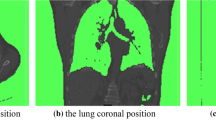Abstract
Microwave ablation (MWA) is a minimal invasive operation for treating lung cancer, and it has been widely used in clinic. Lung contain tracheas and bronchus, and the properties of thermal conductivity, electrical conductivity and density change by variations in the lung’s internal air volume. Thus, it is difficult to control the precise formation of coagulation zones. In this paper, we propose to use finite element method (FEM) to simulate the microwave ablation for lung cancer in a simple lung model. We set the power as 10 watts for 10 s at 2.45 GHz. We built the lung model and a small bronchus was placed close to the opened-tip coaxial antenna with airflow at the rate of 3 L/min. We operated eight patterns including the collapsed and aerated lung in different thermal conductivity, electrical conductivity and density to simulate. The results preliminarily showed that the electrical conductivity had the greatest influence on the microwave ablation temperature field of lung.
Access this chapter
Tax calculation will be finalised at checkout
Purchases are for personal use only
Similar content being viewed by others
References
Phairoh C, Sanpanich A, Kajornpredanon Y, et al.: Airflow effect on microwave ablation in lung model. Biomedical Engineering International Conference 2016, pp. 1–4.
Carrafiello G, Mangini M, Bernardi I D, et al.: Microwave ablation therapy for treating primary and secondary lung tumours: technical note. La Radiologia Medica 115(6), 962(2010).
Shugarman L R, Mack K, Sorbero M E S, et al.: Race and Sex Differences in the Receipt of Timely and Appropriate Lung Cancer Treatment. Medical Care 47(7), 774–781(2009).
Yamazaki N, Watanabe H, Seki M, et al.: Modeling the internal pressure dependence of thermal conductivity and in vitro temperature measurement for lung RFA. Annual International Conference of the IEEE Engineering in Medicine and Biology Society 2011, pp. 5753–5757.
Nan Q, Zhai F, Guo X M.: Study on the temperature field of the endocardial point-by-point microwave ablation of atrial fibrillation. Journal of Beijing University of Technology 40(10), 1579–1585(2014).
H.H. Pennes.: Analysis of tissue and arterial blood temperatures in the resting human forearm. Journal of Applied Physiology, 1, 93(1948).
Zhai F, Nan Q, Zhang H J, et al.: The Comparison of Two Simulation Methods on the Thermal Ablation with Large Blood Vessel, Applied Mechanics & Materials, 444–445 (444-445), 1177–1181(2013).
Yamazaki N, Watanabe H, Lu X, et al.: Development of a temperature distribution simulator for lung RFA based on air dependence of thermal and electrical properties. Engineering in Medicine and Biology Society. IEEE, 2012, pp. 5699–5702.
Sanpanich A, Khongkhanon C, Kajornpredanon Y, et al.: Thermal ablation for cancer treatment by using microwave energy in a simple lung model. Biomedical Engineering International Conference. IEEE, 2015, pp. 1–4.
Acknowledgements
This research is supported by National Science Foundation of China (31771021) and Beijing Natural Science Foundation (3162006).
Author information
Authors and Affiliations
Corresponding author
Editor information
Editors and Affiliations
Ethics declarations
Not applicable.
Competing Interests The authors declare that they have no conflict of interest.
Rights and permissions
Copyright information
© 2019 Springer Nature Singapore Pte Ltd.
About this paper
Cite this paper
Tian, Z., Cheng, Y., Dong, T., Gao, X., Nan, Q. (2019). Numerical Study for Lung Microwave Ablation in Different Thermal and Electrical Properties. In: Lhotska, L., Sukupova, L., Lacković, I., Ibbott, G.S. (eds) World Congress on Medical Physics and Biomedical Engineering 2018. IFMBE Proceedings, vol 68/1. Springer, Singapore. https://doi.org/10.1007/978-981-10-9035-6_104
Download citation
DOI: https://doi.org/10.1007/978-981-10-9035-6_104
Published:
Publisher Name: Springer, Singapore
Print ISBN: 978-981-10-9034-9
Online ISBN: 978-981-10-9035-6
eBook Packages: EngineeringEngineering (R0)




